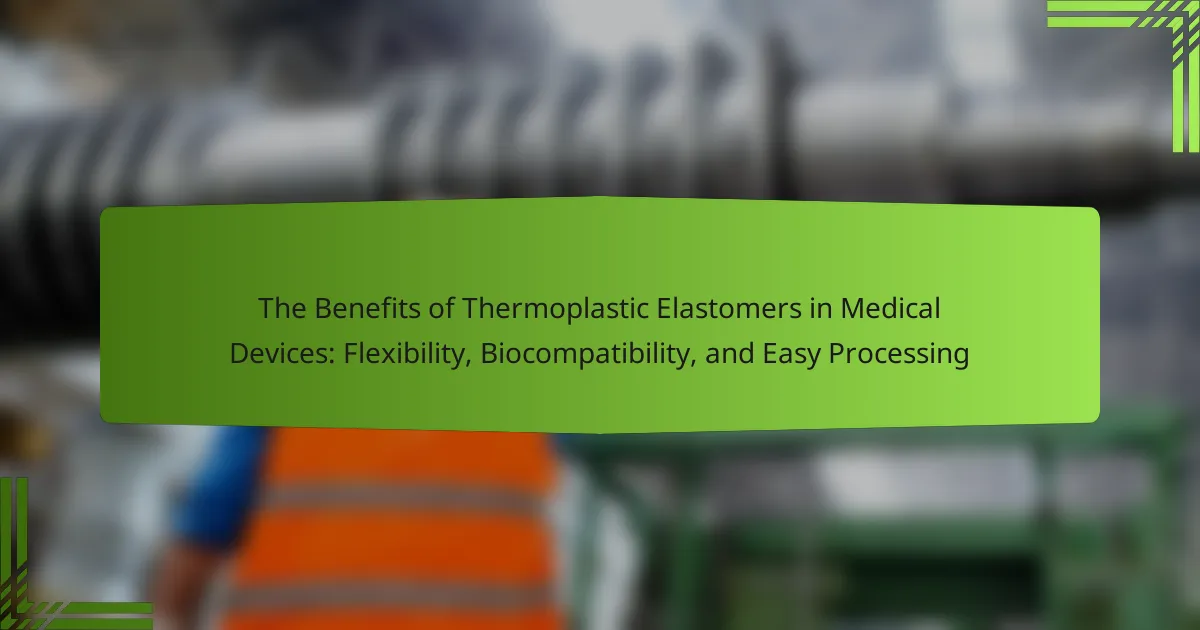Thermoplastic elastomers (TPEs) are specialized polymers that combine the advantageous properties of rubber and plastic, making them highly effective in medical device applications. Their key benefits include flexibility, biocompatibility, and ease of processing, which contribute to patient safety and comfort. TPEs can be molded into complex shapes, enabling innovative designs for devices such as catheters and surgical instruments. Additionally, their chemical resistance and sterilization capabilities enhance durability and reliability in medical environments. This combination of attributes positions TPEs as an essential material in the advancement of modern medical technology.

What are Thermoplastic Elastomers and their Role in Medical Devices?
Thermoplastic elastomers (TPEs) are a class of polymers that combine the properties of rubber and plastic. They exhibit elasticity, flexibility, and durability, making them suitable for various applications. In medical devices, TPEs play a crucial role due to their biocompatibility and ease of processing. Medical devices often require materials that can withstand repeated use while maintaining safety for patients. TPEs meet these requirements by providing a soft touch and resistance to chemicals. Furthermore, TPEs can be easily molded into complex shapes, allowing for innovative designs in medical applications. Their versatility enables manufacturers to create products ranging from catheters to seals and gaskets. This adaptability contributes to the growing use of TPEs in the medical field.
How do Thermoplastic Elastomers differ from traditional materials?
Thermoplastic elastomers (TPEs) differ from traditional materials primarily in their unique combination of rubber-like elasticity and thermoplastic processability. TPEs can be easily molded and reshaped when heated, unlike traditional elastomers that require curing. This ability allows for efficient manufacturing processes, reducing production time and costs. TPEs also exhibit superior flexibility and resilience compared to many rigid materials. They maintain their properties across a wide temperature range, making them suitable for various applications. Additionally, TPEs are often more biocompatible than traditional plastics, which is crucial in medical device applications. Their chemical resistance is also typically higher, contributing to their durability in challenging environments.
What are the key properties of Thermoplastic Elastomers?
Thermoplastic elastomers (TPEs) are materials that combine the properties of rubber and plastic. They exhibit excellent flexibility, allowing them to stretch and return to their original shape. TPEs have good tensile strength, which makes them durable under stress. They are also resistant to chemicals and UV radiation, enhancing their longevity in various applications. Additionally, TPEs can be processed easily using standard plastic manufacturing techniques. This versatility allows for complex shapes and designs in medical devices. Their biocompatibility ensures they are safe for use in contact with biological tissues.
Why are these properties essential for medical applications?
The properties of thermoplastic elastomers are essential for medical applications due to their flexibility, biocompatibility, and ease of processing. Flexibility allows for the creation of devices that conform to the human body, enhancing comfort and usability. Biocompatibility ensures that materials do not induce adverse reactions when in contact with biological tissues. This characteristic is critical for implants and devices used in direct contact with patients. Easy processing facilitates the manufacturing of complex shapes and designs, enabling innovation in medical device development. These properties collectively contribute to improved patient outcomes and device effectiveness.
What types of medical devices utilize Thermoplastic Elastomers?
Thermoplastic elastomers are utilized in various medical devices. Common applications include catheters, tubing, and seals. They are also found in flexible components of medical equipment. Surgical gloves and wearable devices often incorporate thermoplastic elastomers. These materials provide excellent flexibility and biocompatibility. Their easy processing allows for intricate designs in medical devices. The use of thermoplastic elastomers enhances patient comfort and device performance. This versatility makes them a preferred choice in the medical field.
How do Thermoplastic Elastomers enhance device performance?
Thermoplastic elastomers enhance device performance by providing flexibility and durability. They combine the properties of rubber and plastic, allowing for versatile applications in medical devices. This flexibility enables devices to adapt to various shapes and movements. Additionally, thermoplastic elastomers offer excellent resistance to environmental factors, improving device longevity. Their biocompatibility ensures safe interaction with biological tissues. This property is critical for medical applications, where patient safety is paramount. Furthermore, easy processing of thermoplastic elastomers allows for efficient manufacturing and customization of devices. This adaptability leads to innovations in design and functionality, ultimately enhancing overall device performance.
What are some examples of medical devices made with Thermoplastic Elastomers?
Examples of medical devices made with Thermoplastic Elastomers (TPEs) include catheters, seals, and tubing. TPEs provide flexibility and biocompatibility, making them ideal for these applications. Catheters made from TPEs can conform to body contours and provide comfort during use. Seals in medical devices benefit from TPEs’ durability and resistance to chemicals. Tubing made from TPEs is often used in drug delivery systems due to its ease of processing and sterilization. These attributes enhance the performance and safety of medical devices.

What are the key benefits of using Thermoplastic Elastomers in medical devices?
Thermoplastic elastomers (TPEs) offer several key benefits in medical devices. They provide excellent flexibility, allowing for comfortable and adaptive designs. TPEs are biocompatible, ensuring safety for patient contact. Their easy processing enables efficient manufacturing, reducing production times. TPEs also exhibit good chemical resistance, enhancing durability in various environments. Additionally, they can be sterilized, making them suitable for medical applications. These attributes collectively contribute to the effectiveness and reliability of medical devices.
Why is flexibility a crucial benefit of Thermoplastic Elastomers?
Flexibility is a crucial benefit of Thermoplastic Elastomers (TPEs) because it allows for versatile applications in various medical devices. TPEs can easily adapt to different shapes and sizes, making them suitable for components like seals, gaskets, and tubing. Their flexibility ensures comfort and functionality in products like wearable devices and implants. TPEs maintain performance under stress, which is vital for items that undergo frequent movement. Additionally, their ability to return to original shape after deformation enhances durability. Studies show that TPEs can withstand repeated flexing without losing integrity, making them reliable for long-term use in medical applications.
How does flexibility impact patient comfort and device functionality?
Flexibility significantly enhances patient comfort and device functionality. Flexible medical devices conform better to the body’s contours. This adaptability reduces pressure points, leading to increased comfort during use. A study published in the Journal of Biomedical Materials Research indicates that flexible materials improve patient satisfaction. Additionally, flexibility allows devices to maintain functionality during movement. Devices that bend and stretch can perform their intended functions more effectively. For instance, flexible catheters reduce the risk of injury during insertion. Overall, flexibility is crucial for optimizing both comfort and performance in medical devices.
What are the implications of flexibility on device design?
Flexibility in device design enhances user comfort and adaptability. It allows medical devices to conform to the human body more effectively. This adaptability can lead to improved patient compliance and satisfaction. Flexible designs also enable devices to be lightweight and portable. This portability is crucial in medical applications where ease of use is essential. Furthermore, flexibility can improve the durability of devices by reducing stress concentrations. Studies show that flexible materials, such as thermoplastic elastomers, can withstand repeated use without failure. This characteristic is vital for devices that require frequent handling or movement. Overall, flexibility significantly impacts the usability and longevity of medical devices.
How does biocompatibility influence the choice of Thermoplastic Elastomers?
Biocompatibility significantly influences the choice of thermoplastic elastomers (TPEs) for medical applications. TPEs must not induce adverse reactions in the body. This requirement ensures patient safety and device effectiveness. Medical-grade TPEs are often tested for cytotoxicity, irritation, and sensitization. Regulatory standards, such as ISO 10993, guide the evaluation of biocompatibility. TPEs that pass these tests are preferred for implants and devices. Their flexibility and durability also contribute to their selection. Therefore, biocompatibility is a crucial factor in determining the suitability of TPEs for medical devices.
What tests are conducted to ensure biocompatibility?
Biocompatibility tests include cytotoxicity, sensitization, irritation, and systemic toxicity assessments. Cytotoxicity tests determine if materials cause cell death. Sensitization tests evaluate allergic reactions in living organisms. Irritation tests assess the potential to cause inflammation or damage to tissues. Systemic toxicity tests examine effects on organ systems after exposure. These tests are essential for ensuring that materials are safe for medical applications. Regulatory bodies like ISO and ASTM provide guidelines for these tests. Compliance with these standards is critical for product approval in the medical device industry.
Why is biocompatibility significant for patient safety?
Biocompatibility is significant for patient safety because it ensures that medical devices do not provoke adverse reactions in the body. When materials are biocompatible, they integrate well with biological tissues. This reduces the risk of inflammation, infection, and other complications. For example, studies show that biocompatible materials lead to lower rates of rejection in implants. According to the FDA, biocompatibility testing is essential for regulatory approval of medical devices. Therefore, ensuring biocompatibility is crucial for the successful use of thermoplastic elastomers in medical applications.
What advantages does easy processing offer in the manufacturing of medical devices?
Easy processing in the manufacturing of medical devices enhances efficiency and reduces costs. It allows for quicker production cycles, leading to faster time-to-market for new devices. Manufacturers can easily mold complex shapes, which improves design flexibility. This adaptability facilitates the integration of multiple functions into a single device. Easy processing also minimizes waste during production, contributing to sustainability. Thermoplastic elastomers, known for their easy processing, enable high-volume production without sacrificing quality. This results in consistent performance across batches, which is critical in medical applications. Overall, easy processing streamlines manufacturing and enhances device reliability.
How does easy processing affect production efficiency?
Easy processing significantly enhances production efficiency. It reduces the time required for manufacturing processes. This leads to faster turnaround times for products. Simplified processing techniques minimize the need for complex machinery. Consequently, this lowers operational costs. Studies show that streamlined processes can increase output rates by up to 30%. Easy processing also facilitates better quality control. This results in fewer defects and waste during production. Overall, easy processing directly correlates with improved productivity and cost-effectiveness in manufacturing.
What techniques are used to process Thermoplastic Elastomers?
Common techniques used to process Thermoplastic Elastomers (TPEs) include extrusion, injection molding, and blow molding. Extrusion involves forcing TPE through a die to create continuous shapes like sheets or films. Injection molding allows TPE to be heated and injected into molds, forming complex parts. Blow molding is used to create hollow objects by inflating a heated TPE parison within a mold. These techniques are widely adopted due to TPEs’ ability to be reshaped upon heating. They also promote efficient production of medical devices, ensuring flexibility and biocompatibility.

How do Thermoplastic Elastomers contribute to innovation in medical technology?
Thermoplastic elastomers (TPEs) contribute to innovation in medical technology through their unique properties. TPEs combine the flexibility of rubber with the processability of plastics. This makes them suitable for a wide range of medical applications, including catheters and surgical instruments. TPEs are biocompatible, ensuring they are safe for use in the human body. Their ability to be molded into complex shapes allows for advanced designs in medical devices. Additionally, TPEs can be sterilized, maintaining their integrity and performance in medical environments. Research shows that TPEs enhance patient comfort and device usability. These attributes position TPEs as a critical material in the advancement of modern medical technologies.
What challenges do manufacturers face when using Thermoplastic Elastomers?
Manufacturers face several challenges when using thermoplastic elastomers (TPEs). One significant challenge is the processing temperature range. TPEs require specific temperatures for optimal processing, which can vary widely among different types. This variability can lead to difficulties in maintaining consistent product quality.
Another challenge is the compatibility with other materials. TPEs may not bond well with certain substrates, complicating multi-material designs. Additionally, manufacturers must consider the mechanical properties of TPEs. While they offer flexibility, they may not provide the necessary strength for specific applications.
Cost is also a concern. TPEs can be more expensive than traditional materials, impacting overall production budgets. Moreover, manufacturers often face regulatory challenges. Ensuring that TPEs meet medical device regulations can be time-consuming and complex.
Finally, the availability of TPE grades can limit options. Not all suppliers offer the desired formulations, which can hinder product development. Each of these challenges requires careful consideration and planning to ensure successful implementation of TPEs in medical devices.
How can these challenges be overcome?
Challenges related to thermoplastic elastomers in medical devices can be overcome through targeted material selection and innovative processing techniques. Selecting high-quality thermoplastic elastomers enhances biocompatibility and performance. Advanced processing methods, such as 3D printing, improve the adaptability of designs. Implementing rigorous testing protocols ensures materials meet safety and regulatory standards. Collaboration with material scientists can lead to the development of customized elastomers. Continuous research and development facilitate the discovery of new formulations. These approaches collectively enhance the functionality and reliability of medical devices made from thermoplastic elastomers.
What future trends are anticipated in the use of Thermoplastic Elastomers?
Future trends in the use of Thermoplastic Elastomers (TPEs) include increased adoption in medical devices due to their flexibility and biocompatibility. Manufacturers are focusing on developing TPEs with enhanced properties for specific applications. Innovations are expected in the formulation of TPEs to improve their performance in challenging environments. The trend towards sustainable materials is driving the use of bio-based TPEs. Additionally, advancements in processing technologies will enable more efficient production methods. Regulatory compliance will also shape the development of TPEs in medical applications. The market is projected to grow significantly, reflecting the rising demand for versatile materials in healthcare.
What best practices should be followed when selecting Thermoplastic Elastomers for medical devices?
Select Thermoplastic Elastomers (TPEs) based on their biocompatibility. Biocompatibility ensures that materials do not cause adverse reactions in the body. Evaluate the specific application requirements for medical devices. Consider factors like flexibility, durability, and chemical resistance. Assess the regulatory compliance of the TPEs. Compliance with standards such as ISO 10993 is essential for safety. Review the mechanical properties of TPEs to ensure they meet performance needs. Properties like tensile strength and elongation at break are crucial. Test the processing capabilities of TPEs for ease of manufacturing. Efficient processing can reduce production costs and time. Finally, consult with suppliers for technical data and support. Reliable suppliers can provide valuable insights and material certifications.
How can manufacturers ensure optimal performance and safety?
Manufacturers can ensure optimal performance and safety by adhering to strict quality control measures. Implementing comprehensive testing protocols for materials is essential. This includes evaluating thermoplastic elastomers for biocompatibility and mechanical properties. Regular audits of production processes help maintain consistency. Compliance with industry standards, such as ISO 13485, is crucial for medical devices. Training staff on safety protocols enhances awareness and reduces risks. Additionally, utilizing advanced manufacturing techniques can improve product reliability. Continuous monitoring of device performance in clinical settings provides valuable feedback for improvements.
What resources are available for further guidance on Thermoplastic Elastomers?
Technical resources for Thermoplastic Elastomers include academic journals, industry publications, and online databases. Key journals such as the Journal of Polymer Science and Polymer Engineering & Science provide peer-reviewed research. Industry publications like Plastics Today and Rubber & Plastics News offer practical insights. Online databases such as ScienceDirect and Wiley Online Library host extensive articles and studies. Additionally, organizations like the American Chemical Society and the Society of Plastics Engineers provide resources and networking opportunities. These resources support in-depth understanding of thermoplastic elastomers in various applications, including medical devices.
Thermoplastic elastomers (TPEs) are a versatile class of polymers utilized in medical devices due to their unique combination of flexibility, biocompatibility, and easy processing. This article explores the key properties of TPEs, such as their elasticity and chemical resistance, which enhance device performance and patient comfort. It also addresses the challenges manufacturers face when using TPEs and outlines best practices for selecting and processing these materials to ensure safety and reliability in medical applications. Additionally, the article highlights future trends in TPE usage and the importance of adhering to regulatory standards in the medical device industry.


